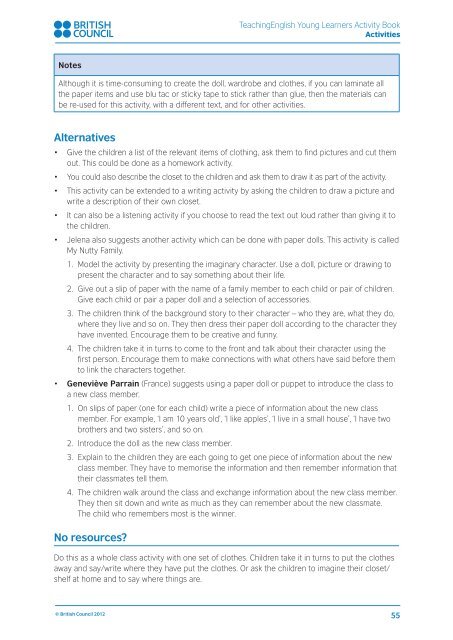url?sa=t&source=web&cd=3&ved=0CC0QFjAC&url=http://www.teachingenglish.org.uk/sites/teacheng/files/B369-Young-Learners-Activity-Book_v10
url?sa=t&source=web&cd=3&ved=0CC0QFjAC&url=http://www.teachingenglish.org.uk/sites/teacheng/files/B369-Young-Learners-Activity-Book_v10
url?sa=t&source=web&cd=3&ved=0CC0QFjAC&url=http://www.teachingenglish.org.uk/sites/teacheng/files/B369-Young-Learners-Activity-Book_v10
Create successful ePaper yourself
Turn your PDF publications into a flip-book with our unique Google optimized e-Paper software.
TeachingEnglish <strong>Young</strong> <strong>Learners</strong> <strong>Activity</strong> <strong>Book</strong><br />
Activities<br />
Notes<br />
Although it is time-consuming to create the doll, wardrobe and clothes, if you can laminate all<br />
the paper items and use blu tac or sticky tape to stick rather than glue, then the materials can<br />
be re-used for this activity, with a different text, and for other activities.<br />
Alternatives<br />
• Give the children a list of the relevant items of clothing, ask them to find pictures and cut them<br />
out. This could be done as a homework activity.<br />
• You could also describe the closet to the children and ask them to draw it as part of the activity.<br />
• This activity can be extended to a writing activity by asking the children to draw a picture and<br />
write a description of their own closet.<br />
• It can also be a listening activity if you choose to read the text out loud rather than giving it to<br />
the children.<br />
• Jelena also suggests another activity which can be done with paper dolls. This activity is called<br />
My Nutty Family.<br />
1. Model the activity by presenting the imaginary character. Use a doll, picture or drawing to<br />
present the character and to say something about their life.<br />
2. Give out a slip of paper with the name of a family member to each child or pair of children.<br />
Give each child or pair a paper doll and a selection of accessories.<br />
3. The children think of the background story to their character – who they are, what they do,<br />
where they live and so on. They then dress their paper doll according to the character they<br />
have invented. Encourage them to be creative and funny.<br />
4. The children take it in turns to come to the front and talk about their character using the<br />
first person. Encourage them to make connections with what others have said before them<br />
to link the characters together.<br />
• Geneviève Parrain (France) suggests using a paper doll or puppet to introduce the class to<br />
a new class member.<br />
1. On slips of paper (one for each child) write a piece of information about the new class<br />
member. For example, ‘I am 10 years old’, ‘I like apples’, ‘I live in a small house’, ‘I have two<br />
brothers and two sisters’, and so on.<br />
2. Introduce the doll as the new class member.<br />
3. Explain to the children they are each going to get one piece of information about the new<br />
class member. They have to memorise the information and then remember information that<br />
their classmates tell them.<br />
4. The children walk around the class and exchange information about the new class member.<br />
They then sit down and write as much as they can remember about the new classmate.<br />
The child who remembers most is the winner.<br />
No resources?<br />
Do this as a whole class activity with one set of clothes. Children take it in turns to put the clothes<br />
away and say/write where they have put the clothes. Or ask the children to imagine their closet/<br />
shelf at home and to say where things are.<br />
© British Council 2012<br />
55





